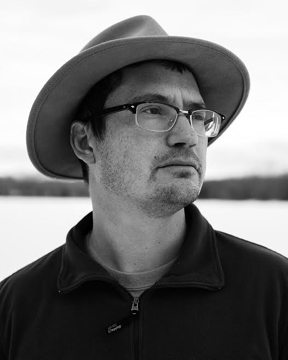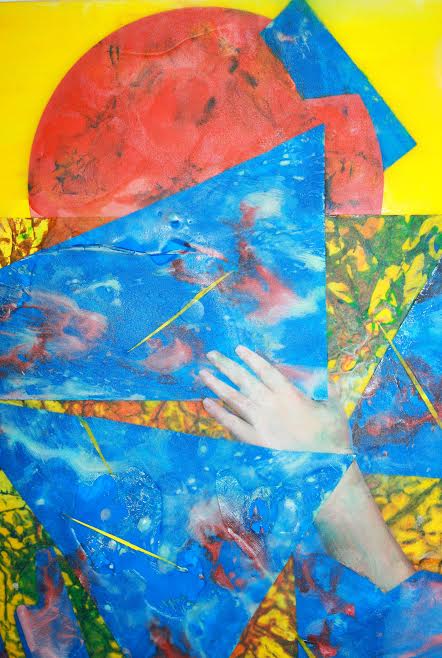Sarah Sadie Busse: To start off, I’m curious when you began to write the poems about Erin’s cancer like at goodwill (radiation, day 32). Was it an immediate response or did it take some time? Did you feel at all resistant to writing about this, or was it a relief?
B. J. Best: We first had suspicions something was wrong in the middle of December 2013. Erin was officially diagnosed the day after Christmas that year. Then quickly came a slew of meetings with doctors to figure out the best course of action and treatment. I felt angry and overwhelmed. I had to start venting, and while generally I don’t value poetry that serves predominantly as therapy, at that point I didn’t care. The first poem I wrote was on December 31, 2013, and it was a genuine relief. I knew writing was something that would help me through the surgeries and treatments, which, more importantly, would allow me to try to help Erin move through them as well.
SSB: In tackling the tough subject of your wife’s cancer, you chose to write formal sonnets. Can you say a little bit about how and why you chose such a strict and traditional form for this material?
BJB: One evening, I had the impulse to write a poem, but as I wrote some tentative lines in my head, it was all inchoate vitriol. I knew I’d never be able to shape it. At that point, I realized I needed a form that would fence me in, that would allow me to be angry under relatively tight constraints. Even though it was an incredibly low priority, I still hoped the poems would have a modicum of literary merit. I’d written a previous book of sonnets—State Sonnets—and I knew I could go back to that familiar form and find my footing. The form helped sharpen that original anger and also direct it as I worked through the machinations of rhyme and counting syllables. I still allowed myself to be angry, but the anger often crystallized into dark humor barbed with audacious rhymes—toadstool / old school is an early one, for example.
SSB: I’m curious about timing of all of this. Wordsworth famously said poems are “emotion recollected in tranquility.” But sometimes people find it helpful to write within the crucible itself, as a way of venting, relieving pressure. Were you writing the poems during the time she was undergoing treatment, or did the poems come after? Or both?
BJB: These poems were written as we went through treatment. I wrote from January through May, when her treatment was completed. I wrote a total of fifty poems, so about three a week. I often wrote them in my head in my car during my forty-five-minute commute—just enough time, I found, to assemble a serviceable first draft, which I often spoke into a voice recorder while driving and then quickly typed up when I got to work. This allowed me to capture details I knew I might forget later, deliberately or not: the hymn etched into the stained glass in the hospital’s nondenominational chapel, or how while grocery shopping in March, our three-year-old son said we should buy my wife daffodils and it was all I could do to not break down right there. It was therapeutic, and they certainly aren’t all good poems. But I had faith that even if no one would ever see them, they were doing important work for me, for us, and that’s all that mattered.
SSB: Do you feel you have more cancer sonnets to write at this point, or is the sequence finished?
BJB: Erin was successfully treated and has been cancer-free since May 2014. So, the sonnets served their initial purpose of helping me hold on. Now comes the less pleasant prospect of becoming the no-nonsense editor. Many poems will simply have to be cut. At that point, I’ll need to decide if the sequence is a chapbook or if it should be a book; if the latter, I’ll have to write some new ones. But part of me, frankly, doesn’t want to write any more about this—I’d rather keep the experience as over and done. So perhaps a chapbook will be its final form. Right now, I’m just letting the poems rest. I haven’t really touched them since mid-2014, and I don’t see me deeply revisiting them for a few more years, until I can feel less likely to become emotionally derailed by them—although I imagine there will always be that possibility.
SSB: You are also a musician in the band Mead Lake’s Most Wanted. Has your wife’s cancer and the experience of treatment made it into any songs? Do you find subject matter moves between your poetry and your songwriting, or do they remain quite separate for you?
BJB: I call my bandmates brothers, and they were a wonderful support group that winter. Our band even got its own sonnet, “the band that i’m in.” Playing music for two hours every Thursday was a good escape. It’s such an escape, in fact, that I deliberately don’t write serious songs. I want the songs I write to be fun to play and hear (“the band that i’m in” quotes real lyrics to a real song I wrote about William Henry Harrison). If I want to approach seriousness, I’ll write poetry. So, in that way, songs and poems really are separate modes of writing for me. Nonetheless, I’ve written one quiet song called “Edna”—it begins with a line from Edna St. Vincent Millay, “The rain is full of ghosts tonight.” In the song, the speaker’s wife dies of breast cancer. I kept the song locked away for a while, but it might now be time to make a demo of it.
SSB: I’m curious how this experience has informed your work, beyond writing the sonnets. Do you feel it has changed you as a writer? In what forms or subjects you might be drawn to in future, or how you approach your writing, or … any other way(s) you might like to consider?
BJB: Perhaps the experience has changed my writing by reminding me it’s a privilege and joy to write—and to live—at all. We were very fortunate that Erin had a successful outcome without too much turmoil. I know that so many people aren’t as lucky. To be able to suffer, fight, and heal means you’re alive. Writing, then, is an extension of that. Overall, this experience has filled me with a deep sense of gratitude. I’m grateful to be writing because I’m grateful to be living.
Sarah Sadie’s chapbook, Do-It-Yourself Paper Airplanes was published by Five Oaks Press in 2015 and a second full-length collection, We Are Traveling Through Dark at Tremendous Speeds, will be published in the coming year. She teaches at the Loft and the University of Iowa Summer Writing Festival, and works with poets one-on-one as well. She participated in Tupelo Press’s 30/30 poetry marathon in December 2015. Find her multimedia blog at sarahsadiesadiesarah.tumblr.



Pingback: at goodwill (radiation, day 32) by B.J. Best | Rkvry Quarterly Literary Journal
Pingback: Roundup: Goodwill and dimes and air mattresses and more « B.J. Best, Poet.